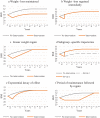A Systematic Review of Methods to Predict Weight Trajectories in Health Economic Models of Behavioral Weight-Management Programs: The Potential Role of Psychosocial Factors
- PMID: 31789103
- PMCID: PMC6985993
- DOI: 10.1177/0272989X19889897
A Systematic Review of Methods to Predict Weight Trajectories in Health Economic Models of Behavioral Weight-Management Programs: The Potential Role of Psychosocial Factors
Abstract
Objectives. There is limited evidence on the long-term effectiveness of behavioral weight-management interventions, and thus, when conducting health economic modeling, assumptions are made about weight trajectories. The aims of this review were to examine these assumptions made about weight trajectories, the evidence sources used to justify them, and the impact of assumptions on estimated cost-effectiveness. Given the evidence that some psychosocial variables are associated with weight-loss trajectories, we also aimed to examine the extent to which psychosocial variables have been used to estimate weight trajectories and whether psychosocial variables were measured within cited evidence sources. Methods. A search of databases (Medline, PubMed, Cochrane, NHS Economic Evaluation, Embase, PSYCinfo, CINAHL, EconLit) was conducted using keywords related to overweight, weight-management, and economic evaluation. Economic evaluations of weight-management interventions that included modeling beyond trial data were included. Results. Within the 38 eligible articles, 6 types of assumptions were reported (weight loss maintained, weight loss regained immediately, linear weight regain, subgroup-specific trajectories, exponential decay of effect, maintenance followed by regain). Fifteen articles cited at least 1 evidence source to support the assumption reported. The assumption used affected the assessment of cost-effectiveness in 9 of the 19 studies that tested this in sensitivity analyses. None of the articles reported using psychosocial factors to estimate weight trajectories. However, psychosocial factors were measured in evidence sources cited by 11 health economic models. Conclusions. Given the range of weight trajectories reported and the potential impact on funding decisions, further research is warranted to investigate how psychosocial variables measured in trials can be used within health economic models to simulate heterogeneous weight trajectories and potentially improve the accuracy of cost-effectiveness estimates.
Keywords: behavioral weight-management; cost-effectiveness analysis; health economic modeling; weight loss maintenance.
Conflict of interest statement
The authors declared no potential conflicts of interest with respect to the research, authorship, and/or publication of this article.
Figures
Similar articles
-
Characteristics Associated With Participation in a Behavioral Weight Loss Randomized Control Trial in the U.S. Military.Mil Med. 2019 Mar 1;184(3-4):e120-e126. doi: 10.1093/milmed/usy199. Mil Med. 2019. PMID: 30125001 Free PMC article. Clinical Trial.
-
Which interventions are cost-effective for the management of whiplash-associated and neck pain-associated disorders? A systematic review of the health economic literature by the Ontario Protocol for Traffic Injury Management (OPTIMa) Collaboration.Spine J. 2016 Dec;16(12):1582-1597. doi: 10.1016/j.spinee.2015.08.025. Epub 2015 Nov 26. Spine J. 2016. PMID: 26631759
-
Modeling Approaches in Cost-Effectiveness Analysis of Disease-Modifying Therapies for Relapsing-Remitting Multiple Sclerosis: An Updated Systematic Review and Recommendations for Future Economic Evaluations.Pharmacoeconomics. 2018 Oct;36(10):1223-1252. doi: 10.1007/s40273-018-0683-9. Pharmacoeconomics. 2018. PMID: 29971666
-
Generalisability in economic evaluation studies in healthcare: a review and case studies.Health Technol Assess. 2004 Dec;8(49):iii-iv, 1-192. doi: 10.3310/hta8490. Health Technol Assess. 2004. PMID: 15544708 Review.
-
Economic Modelling of Chronic Kidney Disease: A Systematic Literature Review to Inform Conceptual Model Design.Pharmacoeconomics. 2019 Dec;37(12):1451-1468. doi: 10.1007/s40273-019-00835-z. Pharmacoeconomics. 2019. PMID: 31571136 Free PMC article.
Cited by
-
The PHEM-B toolbox of methods for incorporating the influences on Behaviour into Public Health Economic Models.BMC Public Health. 2024 Oct 12;24(1):2794. doi: 10.1186/s12889-024-20225-1. BMC Public Health. 2024. PMID: 39395958 Free PMC article.
-
Glucose Lowering through Weight management (GLoW): a randomised controlled trial of the clinical and cost effectiveness of a diabetes education and behavioural weight management programme vs a diabetes education programme in adults with a recent diagnosis of type 2 diabetes.Diabetologia. 2025 May;68(5):969-980. doi: 10.1007/s00125-024-06355-6. Epub 2025 Jan 23. Diabetologia. 2025. PMID: 39849151 Free PMC article. Clinical Trial.
-
The long-term effectiveness and cost-effectiveness of public health interventions; how can we model behavior? A review.Health Econ. 2023 Dec;32(12):2836-2854. doi: 10.1002/hec.4754. Epub 2023 Sep 8. Health Econ. 2023. PMID: 37681282 Free PMC article. Review.
-
Using health economic modelling to inform the design and development of an intervention: estimating the justifiable cost of weight loss maintenance in the UK.BMC Public Health. 2022 Feb 12;22(1):290. doi: 10.1186/s12889-022-12737-5. BMC Public Health. 2022. PMID: 35151300 Free PMC article.
-
Ten-year postintervention follow-up of adolescents participating in the management of overweight and social inequalities (PRALIMAP-INÈS intervention): the PRALIMAP-CINeCO survey protocol.BMJ Open. 2024 Sep 12;14(9):e083090. doi: 10.1136/bmjopen-2023-083090. BMJ Open. 2024. PMID: 39266314 Free PMC article.
References
-
- Stegenga H, Haines A, Jones K, Wilding J. Identification, assessment, and management of overweight and obesity: summary of updated NICE guidance. Br Med J. 2014;349:g6608. - PubMed
-
- Lindgren P, Lindstrom J, Tuomilehto J, et al. Lifestyle intervention to prevent diabetes in men and women with impaired glucose tolerance is cost-effective. Int J Technol Assess Health Care. 2007;23(2):177–83. - PubMed



